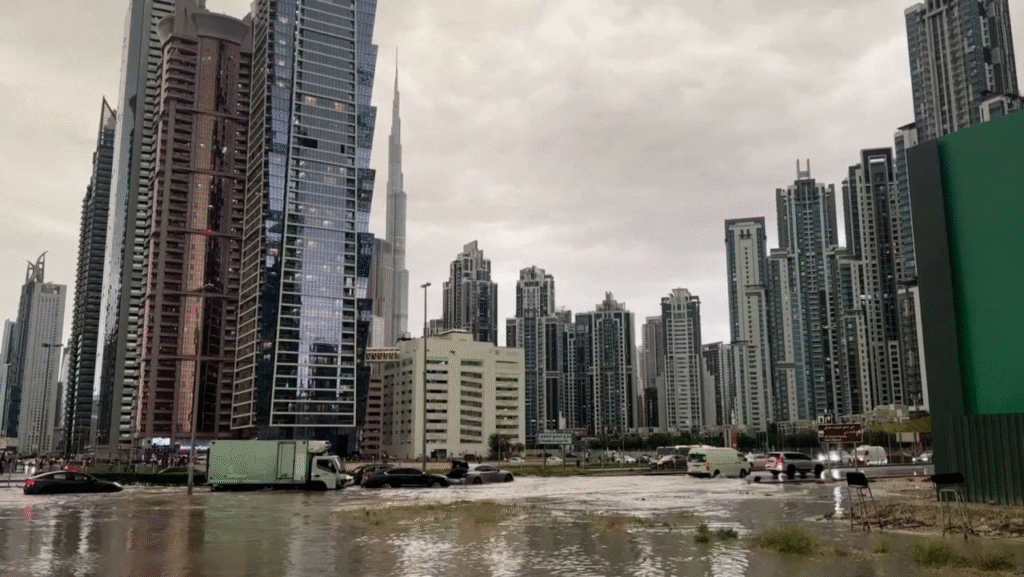Now Reading: Dubai’s Luxury Homes Destroyed by Shocking Rainstorm Disaster 2025
-
01
Dubai’s Luxury Homes Destroyed by Shocking Rainstorm Disaster 2025
Dubai’s Luxury Homes Destroyed by Shocking Rainstorm Disaster 2025

Table of Contents
Dubai, the shining jewel of the United Arab Emirates known for its luxury lifestyle and towering skyscrapers, faced an unexpected crisis this week as rare and powerful rainfall caused massive damage to homes, businesses, and vehicles across the city. Streets were flooded, luxury villas were waterlogged, and even high-end apartment buildings suffered leaks and power failures.
The heavy rain, described as one of the worst in decades, began early in the morning and continued for several hours, leaving residents shocked and unprepared. Authorities reported that many areas of Dubai received over 100 millimeters of rainfall in less than 12 hours, which is more than the city usually sees in an entire year.
Floods Turn Streets Into Rivers

Across Dubai, videos circulated on social media showing streets turned into raging rivers, with cars floating or submerged up to their windows. Popular neighborhoods like Jumeirah, Al Barsha, and parts of Business Bay saw severe flooding. Some residents had to abandon their vehicles and walk through knee-deep water to reach safety.
A resident of Jumeirah Village Circle, Neha Patel, described the chaos:
“Water started pouring into our villa within 20 minutes. The drains were blocked, so it just kept rising. We tried to move our furniture upstairs, but so much was ruined.”
Businesses also faced huge losses as the water seeped into offices, destroying electronics, carpets, and important documents. Shopkeepers in Deira and Bur Dubai reported losing thousands of dirhams’ worth of merchandise.
Luxury Properties Hit Hard
Dubai is known around the world for its high-end real estate, but even these exclusive properties could not escape the damage. In several luxury communities, including Palm Jumeirah and Emirates Hills, residents posted images of flooded gardens, damaged swimming pools, and collapsed ceilings.
A spokesperson for a prominent Dubai-based property developer explained:
“These communities have modern drainage systems, but the rainfall was too extreme to handle. We are working with homeowners to assess and repair the damage.”
Many property owners now fear that their insurance may not fully cover this type of flood damage, raising questions about the readiness of Dubai’s infrastructure to handle climate change–related weather events.
The Cost of Recovery
Early estimates suggest that total property damage across Dubai could reach billions of dirhams. Insurance companies are expecting a flood of claims, from damaged vehicles to completely destroyed household goods.
Construction experts warn that repairing water-damaged buildings is not quick or cheap. Mold growth, weakened structures, and ruined electrical systems can take weeks or even months to fix.
“It is not only about replacing carpets and paint,” explained construction engineer Firas Al-Jabari. “If water has gotten into the foundations or walls, it could compromise the entire structure.”
For renters, the situation is even more complicated. Many tenants in affected areas are struggling to find temporary accommodation while their apartments are repaired, and landlords are trying to arrange emergency maintenance.
Government Response and Public Safety
Dubai’s government responded quickly, dispatching emergency teams to drain flooded roads and rescue stranded residents. The Dubai Municipality shared photos of workers using heavy pumps to remove water from underpasses and tunnels.
Dubai Police also urged drivers to stay off the roads unless absolutely necessary. They reported more than 600 traffic accidents within just a few hours during the downpour, many of them involving vehicles hydroplaning or getting stuck in deep water.
His Highness Sheikh Hamdan bin Mohammed bin Rashid Al Maktoum, Crown Prince of Dubai, posted on social media thanking emergency workers for their efforts and promising to support families who suffered damage.
“Dubai will recover, and we will make sure that every resident is supported,” he wrote.
Could Climate Change Be to Blame?
Meteorologists say that climate change could be making storms like this more common in the Gulf region. Warmer air holds more moisture, leading to heavier and more intense rainfall even in traditionally arid regions like Dubai.
Environmental expert Dr. Laila Hassan warned:
“We must treat this as a wake-up call. Dubai needs to invest in stronger drainage systems and climate-resilient infrastructure to protect residents in the future.”
Some experts believe Dubai should update its building codes to require even higher levels of water resistance, especially in underground parking garages, basements, and electrical systems that were vulnerable during this storm.
Community Spirit Shines

Despite the chaos, many Dubai residents came together to help each other. Volunteers used their own trucks to rescue stranded families, while neighbors opened their doors to those who had lost power or needed shelter.
On social media, stories of generosity spread quickly, showing how people supported one another during the worst of the flooding. Restaurants offered free meals to families forced to evacuate, and volunteers helped clear mud and debris from flooded homes.
What Happens Next?
Cleanup is already underway, but experts say Dubai will be counting the cost of this disaster for months. Insurance adjusters, contractors, and city officials are working around the clock to assess the scale of the damage and begin repairs.
Meanwhile, Dubai’s residents are asking hard questions about how a city famous for its innovation and engineering excellence could be so badly affected by rain. Many hope this disaster will lead to improvements in the city’s infrastructure, making sure it is ready for whatever the future holds.
While the rain has finally stopped, the damage left behind is a powerful reminder that even the world’s most advanced cities are vulnerable to nature’s forces. As Dubai rebuilds, it will need to balance its dazzling growth with stronger protections for its people and properties.
Read More:- Deyaar’s Latest Announcement Shakes Up the UAE Property Market






















